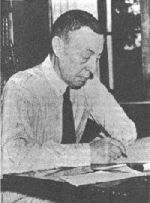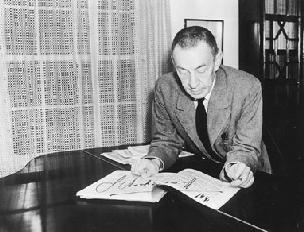Sergei Rachmaninov
 From Conservapedia
From Conservapedia 
Sergei Vasilievich Rachmaninov (Also "Rachmaninoff", "Rakhmaninov")( Semyonovo, Russia, 1873 – Beverly Hills, CA, 1943), Russian composer, pianist, and conductor, was the last of the great Russian romantics - the final heir of Glinka – and much of his music seems to belong more to the 19th century than the times in which he lived. He is best known for his works involving the piano, and for his degree of mastery as a brilliant pianist.
He was born in Tsarist Russia into a family of some nobility, which, however, broke up when he was nine. He showed musical precocity, began studying at home with his mother when 4 and studied at St. Petersburg before being sent to the Conservatory at Moscow where he graduated with distinction both as a pianist and in composition. (A one-act opera, Aleko, was his diploma piece.) Within two years of Aleko’s first performance he had written his first symphony, and some of the piano pieces that support his fame, and had begun a career as one of the great concert pianists of his age. From 1904 to 1906, he also conducted Moscow's Bolshoi Opera.
In 1902, Rachmaninoff married his second cousin, Natalya Satina.
With frequent trips abroad as a pianist, and increasingly to conduct, he was to stay in Russia until the events of the Russian Revolution made him leave. These years had been productive; the technical and emotional framework of his art had matured; and many of the works that make his name were written during this time. When he and his family emigrated, he did so assured of success as a composer of note and one of the world’s greatest pianists.

He arrived in New York in 1918 and was to spend the rest of his life in America, although spending a couple of months of each year based in Switzerland. Composition took second place to his concert appearances. He wrote only a few pieces during the last 30 years of his life, (nothing at all in the ten years to 1927) however they were mostly major works and maintained his fame. His last work, the Symphonic Dances, a piece first published for two pianos, then orchestrated, is a work (possibly once considered for a ballet score) with fire and colour belying its position as his final opus.
Rachmaninov’s position in the affections of the concert goer is assured. He is the natural heir of Tchaikovsky as the most romantic of composers – able to draw melancholy or nostalgia from lyrical melodies underpinned by fine architecture and colourful and subtle orchestration. His pieces for the piano, whilst more at home in the 20th century than his orchestral, choral and dramatic works, are still food for the emotions more than the mind. We are fortunate that he left piano rolls and recordings that show his quality as a pianist.
He died in Beverley Hills Ca. on 28 March 1943.
Contents
- 1 Works
- 2 Of Interest
- 3 See also
- 4 External links
Works[edit]
Orchestral works:
- There are three symphonies, the second of which is one of the most popular of all 20th century symphonies. Various symphonic poems - The Rock and Isle of the Dead are frequently heard. Symphonic Dances and shorter orchestral pieces.
Piano and Orchestra:
- He wrote four piano concertos, with the 2nd being one of the most popular of that genre by any composer. The 3rd is considered more “romantic” but doesn’t have that "adagio sostenuto". [1] Variations on a Theme of Paganini is also well known, and frequently paired with the 2nd Concerto on CD.
Dramatic Works:
- The three operas, all early works, were unsuccessful.
Choral/Vocal:
- Liturgy of St. John Chrysostom and All-Night Vigil are classics of Russian Orthodox music that have gone beyond the boundaries of their origin. He wrote Russian choruses and folksong arrangements, a three movement “choral symphony – The Bells - to the poem by Edgar Allan Poe - and over 70 songs, one of which Vocalise has a career of its own as a short piece for every instrument or ensemble imaginable.
Chamber works:
- Two string trio works (the “trios élégaique”), and a cello sonata.
Piano Works:
- He wrote two piano sonatas, variations on themes by Chopin and Corelli and a number of shorter pieces – notably the Preludes and the “Etudes-tableaux”. There are four works for two pianos. Of all his piano works, the Prelude in C sharp minor (Op.3, No.2) [2] and the Prelude in G minor (Op.23, No.5) [3] seem to be the most frequently heard.
Of Interest[edit]
Rachmaninov’s First Symphony was panned by the critics and caused such mental anguish that after three years of almost complete inactivity as a composer he finally travelled to London for therapy. His next work was the hugely successful Second Piano Concerto, which he dedicated to his therapist.
He was very tall, and was once referred to by the quite short Igor Stravinsky as “six and a half feet of sheer misery”.
The performance by the American soprano, Anna Moffo of “Vocalise” is one of the greatest examples of understated but intensely felt nostalgia and longing in all music.[4]
http://au.youtube.com/watch?v=kU8RwT8ODHA
See also[edit]
- Franz Liszt
- Nikolai Rimsky-Korsakov
- Igor Stravinsky
- Sergei Prokofiev
- Pyotr Ilyich Tchaikovsky
External links[edit]
- Rachmaninoff Society
- The Sergei Rachmaninoff Web Pages Archives
- Sergei Rachmaninoff
- Sergei Rachmaninoff Biography
Categories: [Composers] [Composers] [Pianists]
↧ Download as ZWI file | Last modified: 02/19/2023 16:50:34 | 34 views
☰ Source: https://www.conservapedia.com/Sergei_Rachmaninov | License: CC BY-SA 3.0
 ZWI signed:
ZWI signed: KSF
KSF